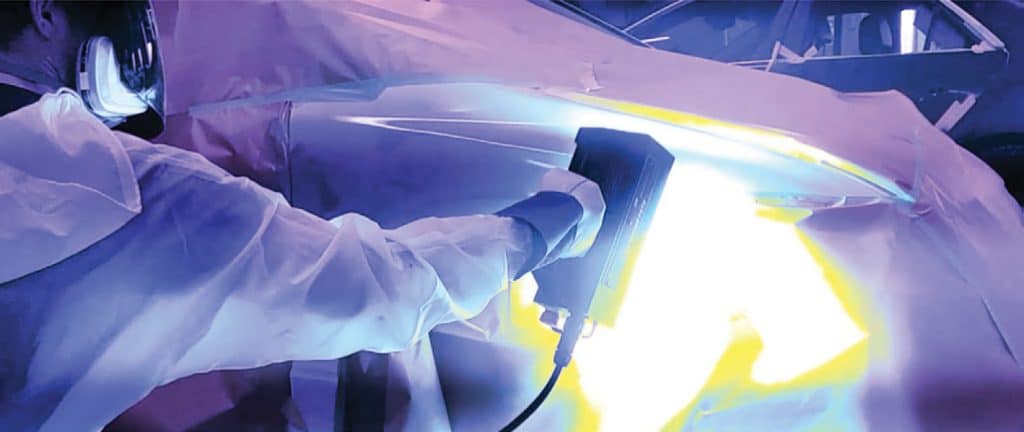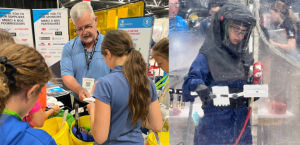ULTRA VIOLET TECH IN COLLISION REPAIR COMES OF AGE
BY STEPHEN ARMSTRONG
Ask an automotive collision repair shop owner about how to increase their productivity and chances are you will hear about the need to reduce pre-paint wait times. After using body filler on a repair, a technician might apply a glaze, followed by a urethane-based primer that must dry fully before painting. Each laborious step can add hours of drying time to the repair timeline, limiting how many vehicles the shop can repair. The opportunity cost in terms of lost revenue and profitability is significant.
Now, however, advanced UV technology is taking the waiting out of the process and delivering near-instant curing of all three prepaint steps: body filler, glazing and priming. By doing so, auto collision shops can process one to two more vehicles each week. Unlike the less efficient UV curing lighting stands of the past decade, the new technology involves powerful handheld UV devices that cover larger areas and cure within seconds.
The time saved with near-instant UV curing directly translates to increased vehicle capacity. Without having to expand a collision repair shop at a cost of up to $150,000 for an additional bay, operators can leverage the latest UV curing technology to increase the number of cars they repair by up to 50 percent. Managing the Pre-Paint Process Historically shops have managed pre-paint steps in one of two ways – either simply wait for the pre-paint steps to dry completely or push the process by moving ahead with painting before a complete dry in order to repair more cars. When an operator decides to shortcut the pre-paint process, they risk incurring shrinkage which is when blemishes such as pin holes appear on a paint’s surface. What appears at first to be a perfect coat can be marred a month or two later by shrinkage caused by insufficient drying. This leads to customer complaints, risk to a shop’s reputation with customers and insurance companies, and costly resprays.
The decision to wait out or push the prepaint process stems from the limitations of the UV curing systems previously available to collision repair shops. UV light stands must be physically moved around the repair area as the drying scope of a light stand is quite small–about the size of a man’s hand. Achieving consistent curing is difficult as a technician must both accurately place the stand to cover the entire repair as well as judge how long it remains in each location. Prior generations of mobile UV systems present other issues. Because of their bulk and weight, the units are difficult for an operator to hold in place for the three to five minutes of curing and there is no indicator that the cure was completed. If a spot is missed or insufficiently cured, it can be a huge problem when the operator goes to sand the surface. Whether a mobile unit or a light stand, past UV systems have been underpowered. Most units provide up to 250 mw/cm2 of UV light. While stronger than the 10 mw/cm2 that is available when curing a car outdoors in the sun, this level is not high enough to complete a vehicle quickly and thoroughly.
Solving the Wait Time Advancements in UV curing systems have recently resulted in a new mobile solution for collision repair shops that delivers near-instant curing to enable operators to complete their pre-paint steps without costly delays. Kemperle, a 53-location family-run collision repair distributor based in Amityville, NY supplies collision repair shops along the East Coast from New England to Miami. Recently, the company found an advanced UV system from SPDI UV that could eliminate the pre-paint wait time. “It’s been like creating time for our customers,” said Brian Gear, territory manager at Kemperle and a 33-year veteran of the collision repair industry commenting on the UV Fastlane system. “What they really like about it is that it keeps the technician’s hands on the car throughout the entire repair process because of the near-instant curing. This leads to higher quality and faster throughput.”
With the Fastlane system, an operator waves a mobile wand over the repair surface, just as they would to spray paint. The body filler, glaze or primer dries within seconds. In addition to being designed for comfortable use, the wand delivers 2400 watts of curing power to a depth of up to 12 Mil on a single pass based on a high intensity irradiator. This compares to the majority of UV lights which have at most 400 watts. The UV Fastlane curing system was developed by SPDI UV, a Delray Beach, Florida based UV technology company founded in 1992. The company holds a patent for handheld UV curing in the automotive collision industry. “With the near instant UV curing, it is now possible to do same-day repairs and add one more car a day of throughput. If you assume an average repair order of $2,500, a collision repair shop can significantly increase their profitability and pay back the entire cost of the UV system within weeks.”
The UV light field is designed to be larger than the normal spray path so that non-UV light does not dilute the impact. This enables greater texture and consistency in application and avoids delamination and failure issues downstream because of a lack of absolute uniformity. For added confidence, the company developed 2 methods to indicate to the user when the substrate is fully cured. For primer, there are visualizer strips that can be put directly on the masking tape defining the perimeter of the area to be painted. When the primer is fully cured, the strips will turn from yellow to green. For filler, the UV body filler will actually change colors from green to gray when fully cured. This takes the guesswork in application and the risk of shrinkage occurring later.
From a collision repair operator’s perspective, the advancements in UV curing technology can be transformative. Car Star Body Shop, a 15-bay facility in Troy, Ohio that specializes in RVs has seen this first hand. “We used to have our RVs sit until the next day waiting for the primer to dry. Now we complete the cure in half an hour,” said Bill Moore, production manager. “The Fastlane technology has changed my business completely as a result.” The benefits of instant UV curing actually start with the application of the UV primer itself. No mixing is required and what is not used on a day’s operations can be used in the future with no degradation in quality. This compares to a usable life of only about 45 minutes for a urethane-based primer. This means unless a shop mixes the absolute right amount, a lot of traditional primer gets wasted with additional time required cleaning spray guns, cleaning cups and mixing more primer. And when an UV primer is applied there is less waste as it uses 40 percent less material enabling it to be applied in a thinner coat. A lot of urethane primer can end up in the air because it is not made of 100 percent solids. “There is absolutely no shrinkage to worry about after we primed. Once you are dry, you are dry,” said Moore. We are now completing three to four RVs a week and are on track to do five. That’s real money for us.”
Additional Operational Impact While increasing the number of vehicles that can be repaired without adding bays is the biggest win for collision repair shops, there are additional benefits to completing pre-paint dry times more quickly. Any time a car is not being actively worked on in a shop will impact an insurance company’s evaluation. Known as ‘Touch Time’, the metric divides the number of hours to repair a car by the number of days in the shop. The longer a car sits in a shop without it being actively worked on, such as during dry times, will lower a shop’s score risking a valuable source of insurance referrals. Repair shops can also be responsible for a customer’s rental car charges after the amount of time the insurance company will pay. Delays in drying and curing can dilute the profitability of a repair order when a shop incurs this expense.
Automotive collision repair shops can put the era of UV light stands, guesswork in making and applying the right amount of primer, and pre-paint downtimes in their rear-view mirror. Adds Gear, “after my customers have tried the new near instant UV curing systems, they tell me that they have been doing it wrong all these years. The reduction in wait times is that significant to their workflows.”
Stephen Armstrong is a California-based writer who has researched and written about industrial technologies, healthcare, automotive and international trade for the past 15 years. This piece was written with the support of UV Fast Lane.



























